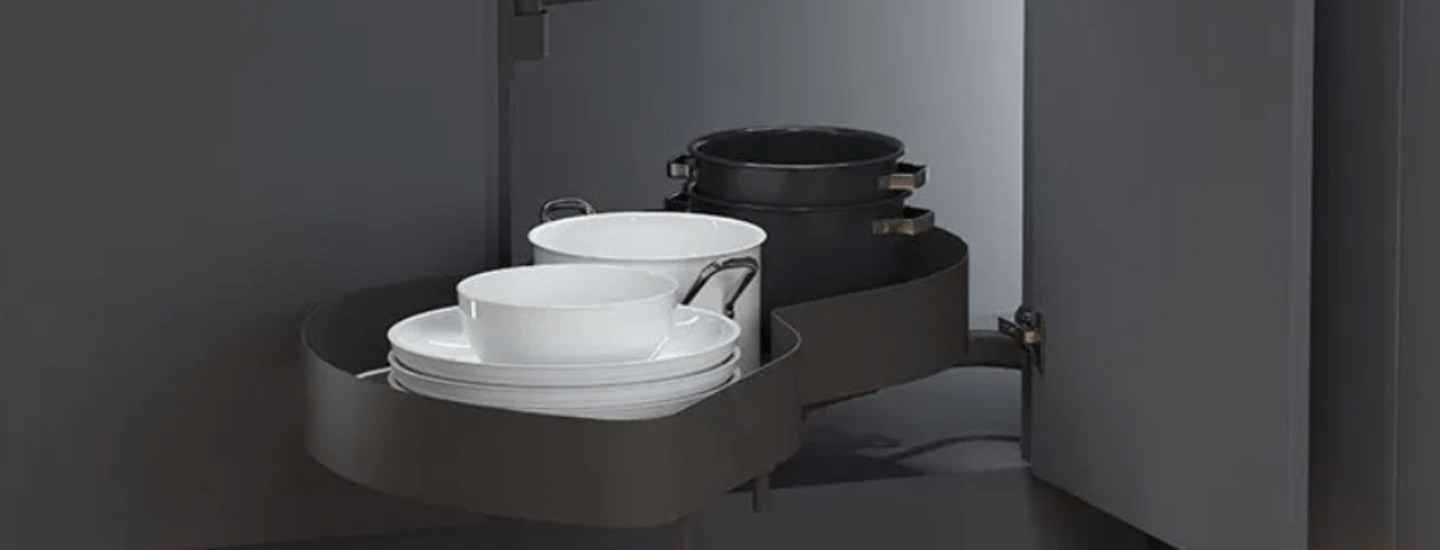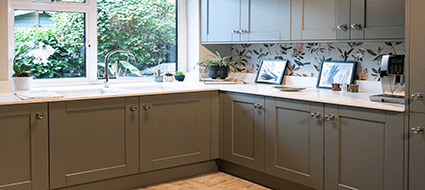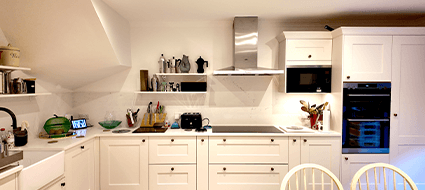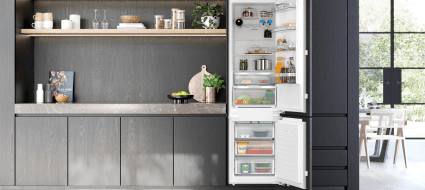By Turab
April 22, 2025
Introduction to Cabinet Kitchen Corners
In any kitchen design, corners often become the most underutilized or awkward spaces. Yet, these very corners hold immense potential if planned wisely. A well-designed cabinet kitchen corner can transform a dull nook into a functional and stylish storage area that improves workflow, organization, and overall aesthetics.
Kitchen corners pose unique challenges. Whether you're dealing with L-shaped, U-shaped, or galley kitchens, corners tend to collect clutter or remain empty due to poor accessibility. However, with the evolution of modern cabinetry and intelligent space-saving solutions, it’s now possible to turn these corners into some of the most productive zones in your kitchen.
The key lies in choosing the right type of cabinet and interior mechanism for the corner. From lazy Susans and pull-out drawers to blind corner units and open shelving, today’s options are as varied as they are functional. You can also personalize the look to match your kitchen’s theme—whether it's traditional, contemporary, rustic, or minimalist.
Designing a cabinet kitchen corner involves careful planning, understanding traffic flow, appliance placement, and your everyday needs. But once it’s done right, it can make your cooking space more ergonomic and less cluttered. In this guide, we’ll explore creative solutions, design trends, installation tips, and where to find premium cabinet kitchen corner units for your renovation project. So, if you’ve been ignoring those corners, it’s time to turn your attention to them—they’re the secret to a smarter kitchen.
Understanding the Challenge of Kitchen Corners
The challenge with kitchen corners lies not in their size, but in their shape and accessibility. These tight spots can be hard to reach, awkward to open, and even trickier to organize. If you’re not using the right design or cabinet, your kitchen corner may end up as dead space—or worse, a clutter trap.
Traditionally, kitchen corners were either left open or had basic shelves. While that might have worked in older kitchen layouts, modern homes demand more efficient use of every inch. The average UK kitchen isn’t massive, so wasted space is no longer an option.
A cabinet kitchen corner has to contend with two walls meeting at a 90-degree angle, limiting access and visibility. Without the right interior mechanism—like a rotating shelf or sliding tray—items stored in the back remain unreachable. Moreover, standard cabinet doors don’t function well in corners, leading to jamming or wasted vertical space.
There’s also the issue of appliance placement. Dishwashers, ovens, or even sinks installed too close to a corner cabinet can make it difficult to open the doors fully. That’s why a smart corner solution must consider the entire layout and workflow of the kitchen.
Understanding these constraints is the first step toward designing a solution that works. With the right choice of cabinet, hardware, and layout, you can convert even the trickiest corner into a functional and attractive storage zone that supports daily kitchen activities and enhances the overall space.
Types of Cabinet Kitchen Corner Solutions
There are several innovative cabinet styles specifically designed to address the kitchen corner challenge. Each comes with its own set of benefits, depending on your kitchen’s size, layout, and your specific storage needs.
One of the most common types is the lazy Susan—a rotating, circular shelf that lets you spin items into view. It’s ideal for storing dry goods, spices, or even cookware. Lazy Susans come in full-circle or kidney-shaped formats, fitting neatly into corner cabinets and improving accessibility.
Another popular choice is the blind corner cabinet, which reaches deep into the corner but includes pull-out trays that slide and pivot outward. These are excellent for maximizing deep storage space and allow access without having to reach blindly into the depths.
Diagonal corner cabinets are built at a 45-degree angle, often featuring a single hinged door that opens to reveal a spacious triangular interior. These can store larger items but may need custom shelving to optimize their capacity.
Then there are corner drawers—a sleek, modern solution where the cabinet fronts are cut to fit the 90-degree angle, creating two-tiered drawers that slide out diagonally. These are perfect for storing utensils, linens, or small gadgets.
Open shelving in corners is another emerging trend, especially for kitchens with a minimalist design. While they don’t hide clutter, they offer a light and airy feel and are ideal for displaying attractive dishware or décor.
Maximizing Storage in a Cabinet Kitchen Corner
The ultimate goal of any cabinet kitchen corner is to make the most out of limited space. That means organizing with intention, utilizing every nook, and choosing cabinet features that enhance function.
Start by identifying what you want to store in the corner. Items used less frequently—like slow cookers, large pots, or seasonal bakeware—are well-suited for deeper shelves or blind corner units. Everyday items, on the other hand, benefit from easy-access solutions like lazy Susans or pull-out drawers.
Use tiered shelving inside the cabinet to separate items by size or type. This prevents small things from getting lost under bulkier items. If your cabinet has a fixed shelf, consider installing a removable riser or a stacking system.
Lighting is another overlooked element in corner cabinets. Adding LED strips or a battery-operated touch light inside can significantly improve visibility. This is especially helpful for deep or dark-colored cabinets.
You can also use labelled bins or baskets to keep smaller items grouped together. This adds order and makes it easier to find what you need. Corner cabinets with custom dividers or organizers for specific tools—like chopping boards or baking trays—are also worth the investment.
Remember, every inch counts in kitchen storage. By planning carefully and choosing the right cabinet features, your kitchen corner can become one of the most efficient areas in your home.
Stylish Design Ideas for Corner Cabinets
Functionality doesn’t have to come at the expense of style. In fact, the right cabinet kitchen corner can become a focal point that enhances your entire kitchen’s look. There are numerous design possibilities to explore, each tailored to your aesthetic preferences and lifestyle.
One stylish approach is to match the corner cabinet fronts with the rest of your cabinetry but add a contrasting countertop or handles to draw visual interest. This subtle distinction turns the corner into a deliberate design element rather than a forgotten nook.
For a modern kitchen, consider flat-front cabinet doors with hidden pull-out trays. These create a sleek and seamless appearance while hiding the practical storage within. High-gloss finishes in shades of white, grey, or navy add a contemporary flair.
If your kitchen leans more traditional or rustic, opt for shaker-style doors or open shelving in the corner. Exposed wooden shelves in corners are perfect for displaying heirloom dishes, ceramic jugs, or glass jars filled with pasta or herbs.
- Glass-front corner cabinets add an elegant touch while keeping the space visually light. You can enhance this look with interior lighting, showcasing your glassware or fine china.
- Another creative idea is to install a corner wine rack or diagonal open shelf with criss-cross dividers. It not only fills the space but also adds character and function.
Your cabinet kitchen corner doesn’t have to be hidden or dull—it can become a stylish expression of your kitchen’s personality.
Custom vs. Pre-Made Corner Cabinets
When designing a cabinet kitchen corner, one of the key decisions you’ll face is whether to go with a custom-built cabinet or a pre-made (modular) solution. Each option has its pros and cons, and your choice should align with your budget, kitchen layout, and design goals.
- Pre-made corner cabinets are readily available and come in standard sizes and formats. They’re more affordable and faster to install, making them ideal for quick renovations or budget-conscious upgrades. Options like lazy Susans, blind corner pull-outs, and diagonal cabinets are commonly offered by major retailers and kitchen brands.
However, because they come in fixed dimensions, pre-made cabinets may not utilize your space as efficiently, especially in unusually shaped kitchens or older homes with uneven walls.
- Custom corner cabinets, on the other hand, are tailored to fit your kitchen’s exact specifications. You have the freedom to choose every detail—from the cabinet depth and shelf configuration to the materials, colors, and hardware. Custom solutions are ideal if you have specific storage needs, an unconventional layout, or a strong design vision.
While custom work involves a higher upfront cost, it often results in a more cohesive and functional kitchen. You’ll also enjoy the benefit of craftsmanship and unique design that reflects your personal style.
Installation Tips for Corner Cabinets
Installing a cabinet kitchen corner requires precision and planning to ensure it integrates seamlessly with the rest of your kitchen. Whether you’re doing a DIY project or hiring professionals, there are a few best practices to keep in mind.
Start by measuring the corner accurately, including the depth, height, and angle of both adjoining walls. Double-check for any wall irregularities, existing electrical points, or pipes that could interfere with the cabinet placement.
Plan the installation in conjunction with your other base and wall cabinets to ensure a uniform line and consistent spacing. Position the corner cabinet first, then work outward toward adjacent units. This approach helps establish a clean layout and ensures symmetry.
If you’re installing a pull-out or lazy Susan cabinet, make sure to account for door swing clearance. Adjacent appliances or cabinetry should not obstruct the operation. Also, check that the interior mechanism can rotate or slide fully without hitting surrounding hardware.
Use high-quality fasteners and mounting brackets to ensure the cabinet is securely attached, especially since corner cabinets often carry heavier loads. Level the cabinet from all angles before final tightening, as an uneven cabinet can cause drawers to slide open or doors to misalign.
Seal any visible gaps with caulk or trim molding for a polished look. And lastly, install soft-close hinges or glides to enhance the cabinet’s durability and user experience.
Proper installation ensures your corner cabinet performs well and looks great for years to come.
Where to Buy Cabinet Kitchen Corner Units
If you’re ready to upgrade your kitchen with a functional and beautiful cabinet kitchen corner, choosing the right supplier is key. You want a source that offers not only a wide range of options but also reliable quality, expert guidance, and professional support.
That’s where smithinteriors.uk comes in. We specialize in premium kitchen cabinetry, including smart corner cabinet solutions that blend perfectly with any home style. Whether you’re seeking a traditional corner unit, a modern pull-out, or a fully customized piece, our team will help you find the perfect fit.
At Smith Interiors, we understand that no two kitchens are alike. That’s why we offer bespoke services tailored to your layout, taste, and needs. Our cabinet kitchen corner units are crafted using high-grade materials, ensuring they withstand daily use and retain their beauty over time.
Our collection includes everything from high-gloss modern styles to handcrafted wooden classics, with customizable storage solutions like rotating trays, deep drawers, and corner shelving. We also provide professional design consultations and can help you visualize how your new corner unit will function within your kitchen.
Visit smithinteriors.uk today to explore our range or schedule a consultation with one of our kitchen specialists. With expert advice, quality products, and unbeatable service, Smith Interiors is your go-to partner for making every corner count.



